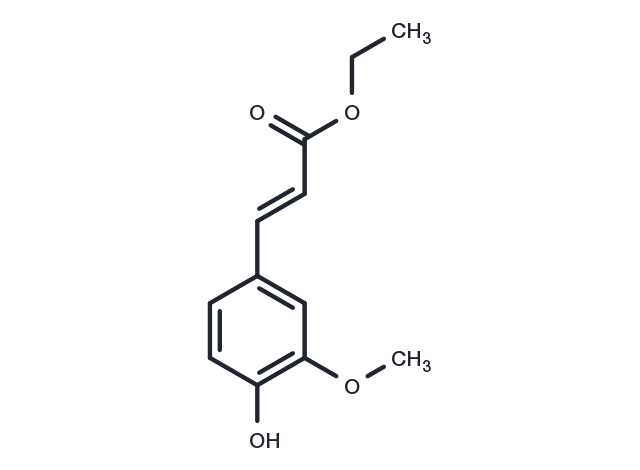Powder: -20°C for 3 years | In solvent: -80°C for 1 year


Ethyl ferulate could be used for therapeutic purposes as a potent inducer of HO-1 for the protection of brain cells against oxidative and neurodegenerative conditions.

| Pack Size | Availability | Price/USD | Quantity |
|---|---|---|---|
| 20 mg | Inquiry | $ 245.00 |
| Description | Ethyl ferulate could be used for therapeutic purposes as a potent inducer of HO-1 for the protection of brain cells against oxidative and neurodegenerative conditions. |
| In vitro | In the CNS, the heme oxygenase (HO) system has been reported to be active and to operate as a fundamental defensive mechanism for neurons exposed to an oxidant challenge. We have recently shown that both curcumin and caffeic acid phenethyl ester, two phenolic natural compounds, potently induce HO-1 expression and activity in rat astrocytes. We have extended our previous findings examining the effects of two other plant-derived phenolic compounds, with analogous chemical structures, in rat astrocytes and neurons. METHODS AND RESULTS: Ethyl ferulate (Ethyl (E)-ferulate, ethyl 4-hydroxy-3-methoxycinnamate) (EFE), the naturally occurring ester of ferulic acid, was able to induce HO-1 protein expression. Maximal expression of HO-1 mRNA and protein and a significant increase in HO activity were detected after 6 h of incubation with 15 microM EFE in astrocytes and 5 microM EFE in neurons. Higher concentrations of EFE (50 microM) caused a substantial cytotoxic effect with no change in HO-1 protein expression and activity. Exposure of astrocytes to resveratrol, a phytoalexin derived from grapes, resulted in an increase of HO-1 mRNA, but it was not able to induce HO-1 protein expression and activity. Interestingly, preincubation (12 h) of neurons with EFE resulted in an enhanced cellular resistance to glucose oxidase-mediated oxidative damage; this cytoprotective effect was considerably attenuated by zinc protoporphyrin IX, an inhibitor of HO activity. CONCLUSIONS: This study identifies a novel natural compound that could be used for therapeutic purposes as a potent inducer of HO-1 for the protection of brain cells against oxidative and neurodegenerative conditions. |
| Source |
| Molecular Weight | 222.24 |
| Formula | C12H14O4 |
| CAS No. | 28028-62-8 |
Powder: -20°C for 3 years | In solvent: -80°C for 1 year
You can also refer to dose conversion for different animals. More
bottom
Please see Inhibitor Handling Instructions for more frequently ask questions. Topics include: how to prepare stock solutions, how to store products, and cautions on cell-based assays & animal experiments, etc.
Ethyl (E)-ferulate 28028-62-8 Ethyl (E) ferulate Ethyl (E)ferulate Ethyl ferulate inhibitor inhibit
